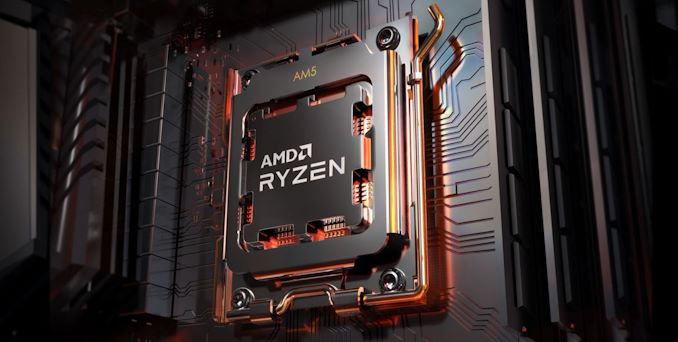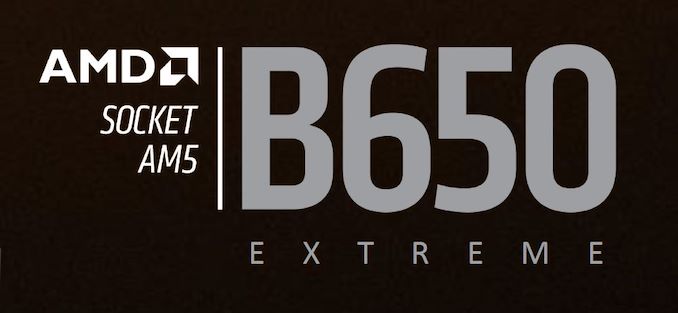AMD Announces B650 Extreme Chipset for Ryzen 7000: PCIe 5.0 For Mainstream
by Gavin Bonshor on August 29, 2022 7:35 PM EST- Posted in
- Motherboards
- AMD
- Ryzen
- 5nm
- Zen 4
- AM5
- LGA1718
- Ryzen 7000
- B650E
- B650 Extreme

Over the last couple of months, the rumor mill surrounding AMD's impending Ryzen 7000 processors for desktops has been in overdrive. Although Lisa Su unveiled Zen 4 back at CES 2022, it's been anticipated that the new AM5 platform would include multiple chipsets, much like AM4 has over 500+ motherboard lifespan from X370, X470, X570, and every chipset in between.
AMD announced its X670E, X670, and B650 chipsets during the AMD Keynote at Computex 2022, and this evening, AMD has announced a fourth chipset for Ryzen 7000, the B650E chipset. The B650E chipset will run alongside the already announced B650 chipset, but as it's part of AMD's 'Extreme' series of chipsets, it will benefit from PCIe 5.0 lanes to at least one M.2 slot, as well as optional support for PCIe 5.0 to a PCIe graphics slot, features not available with standard B650 boards.
During AMD's Keynote at Computex 2022, AMD's CEO Lisa Su unveiled three AM5 chipsets designed to harness the power of its 5 nm Zen 4 cores within the Ryzen 7000 processors. We already knew the AM5 socket was based around a Lane Grid Array (LGA) socket with 1718 pins, aptly named LGA1718. Some of the significant benefits coming to AM5 include native PCIe 5.0 support from the CPU, not just for use with the PCIe slots, but also in the way of PCIe 5.0 storage, where the first consumer drives are expected to start rolling out in November 2022.
AMD's latest announcement of the B650E (Extreme) chipset gives motherboard vendors and users the option of a lower-cost platform but without sacrificing the longevity and expansion support of PCIe 5.0. The X670E chipset is reserved for its most premium models, such as the flagship ASUS ROG Crosshair X670E Extreme motherboard, unveiled at Computex 2022.
| AMD AM5 Chipset Comparison | ||||
| Feature | X670E | X670 | B650E | B650 |
| CPU PCIe (PCIe) | 5.0 (Mandatory) 2 x16 Slots |
4.0 (5.0 Optional) |
5.0 (Highly Suggested) | 4.0 (5.0 Optional) |
| CPU PCIe (M.2 Slots) | At Least 1 PCIe 5.0 Slot | |||
| Total CPU PCIe Lanes | 24 | |||
| SuperSpeed USB 20Gbps (USB 3.2 Gen 2x2) |
Up To 14 | |||
| DDR5 Support | Quad Channel (128-bit bus) Speeds TBD |
|||
| Wi-Fi 6E | Yes | |||
| CPU Overclocking Support | Y | Y | Y | Y |
| Memory Overclocking Support | Y | Y | Y | Y |
| Available | September 2022 | October 2022 | ||
Update 08/31: We received a note from AMD PR this morning confirming that the B650/B650E series boards will support CPU overclocking. Our table has been updated accordingly
Using PCIe 5.0 lanes requires a more premium PCB, usually with more layers which allows the tracks to keep signal integrity, but this typically adds cost. The existence of the B650E chipset will enable vendors to use more expensive PCIe 5.0 laning with more modest controller sets, which allow vendors to offset the cost. Ideally, it gives users a broader and more future-proof platform to upgrade with, but without breaking the bank on unnecessary controller sets; users wanting the best controller sets should opt for X670 or X670E.
This ultimately means that AMD will have a mainstream platform that has PCIe 5.0 by default (B650E) and a lower-cost alternative with just PCIe 4.0 lanes to the PEG and M.2 slots. AMD is strongly prodding motherboard vendors to offer at least one PCIe 5.0 M.2 slot for storage on most of their boards, as this is one of the main benefits of AMD's AM5 platform.
As announced by AMD during its together we advance_PCs event, the Ryzen 7000 processors for desktop will launch on September 27th, with both motherboards from the X670E and X670 chipsets. The motherboards featuring the B650E and B650 chipsets will be available to purchase at a later date in October.
Source: AMD












24 Comments
View All Comments
meacupla - Monday, August 29, 2022 - link
Okay, I can see the X670E having a difference, but there seems to be almost no differentiation for the other three.Also, AMD, please stop copying the bad parts of intel and stop using "B and E" for your chipsets. In particular, please stop using "B" for your chipsets, it's confusing a fuck
Hul8 - Monday, August 29, 2022 - link
I think the amount of I/O is a pretty big differentiator.Both X670E and X670 have dual chipsets so they almost double the possible number of PCIe, SATA and USB connections from the chipset compared to either B650 variant. (The scaling is not perfect since x4 PCIe lanes are lost on the first chipset due to daisy-chaining.)
I'd look at the "E" and "non-E" more as variants instead of distinct chipsets. "E" just designates better PCIe Gen 5 support.
meacupla - Monday, August 29, 2022 - link
That's the thing though, AMD hasn't bothered to offer any more details.In the graph, it only says "up to 14 USB 3.2 Gen2x2" on all of them?" and then we have zero idea how many PCIe lanes and SATA ports are offered from the I/O chip.
I guess I'll just have to wait for more announcements from AMD.
ValhallasAshes - Thursday, September 1, 2022 - link
I think you need to be more specific when you simply say I/O chip. Because you say we have no idea as to the number of PCIE lanes on the I/O chip, but we do. Remember, the CPU also has an I/O chip (1 I/O die and 2 core complex dies). So we know the new CPUs have the same number of PCIE lanes as last generation. What we don't know is how many additional PCIE lanes the Motherboard Chipset offers.Right now everyone is making all this noise about PCIE Gen 5. But we can barely even saturate Gen 4. And we can only do that with NAND storage. Graphics cards, even next gen graphics cards can't and won't saturate a gen 4 lane, let alone a gen 5 lane. So I don't understand why it's such a big deal when we have for more issues in general running out lanes than we do running into bandwidth limitations.
Having all that extra bandwidth in PCIE Gen 5 is nice...for the future. But what I need now, is more PCIE lanes so I can do more with the system I have for more storage drives (both NVME and SATA). I don't need Threadripper levels PCIE Lanes, but I definitely need more than what was offered on the AM4 socket. If they're not going to offer more CPU based PCIE lanes with Ryzen 7000, then I'm really hoping that with AM5 and PCIE Gen5, they finally start offering more chipset based PCIE lanes. I may not need the extreme resources of a full on Threadripper workstation, but I definitely need more room to breath than they're offering right now.
ET - Tuesday, August 30, 2022 - link
I'm sure that using B for chipsets was a deliberate marketing move that AMD used to annoy Intel (and confuse users). It forced intel to move from B250 to B360, as B350 was already taken by AMD.While this tactic might not be that relevant these days, AMD users are already used to Bx50 from AMD, so there's no good reason to move from this.
I agree that 'E' is somewhat confusing, but I still think it has more benefit than not. The alternatives would have been to either not offer functionality distinction at all, which I think would have been worse for OEMs and users alike, or offer different chipset names for different functionalities, such as X675 and B355 instead of X670E and B350E, which might have been a bit of an improvement but not significantly so, IMO.
shabby - Monday, August 29, 2022 - link
Pcie5 is optional of x670? Wtf?Ryan Smith - Monday, August 29, 2022 - link
To quote AMD's own press release:AMD X670 Extreme: Bringing the most connectivity and extreme overclocking capabilities11 with
PCIe 5.0 support for graphics and storage
AMD X670: Supporting enthusiast overclocking with PCIe® 5.0 support for storage and optional
graphics support
AMD B650E: Designed for performance users with PCIe® 5.0 storage support and optional
graphics support
AMD B650: Designed for mainstream users with support for DDR5 memory and optional PCIe®
5.0 support
shabby - Monday, August 29, 2022 - link
I would expect the pcie slot to be 5.0 also, it seems like it wont be.nandnandnand - Tuesday, August 30, 2022 - link
We'll just have to see how this shakes out, and read the motherboard specs carefully before you buy anything.boozed - Tuesday, August 30, 2022 - link
That's the "optional graphics support" most likely. I'd expect most retail motherboards to have it enabled as a selling point.